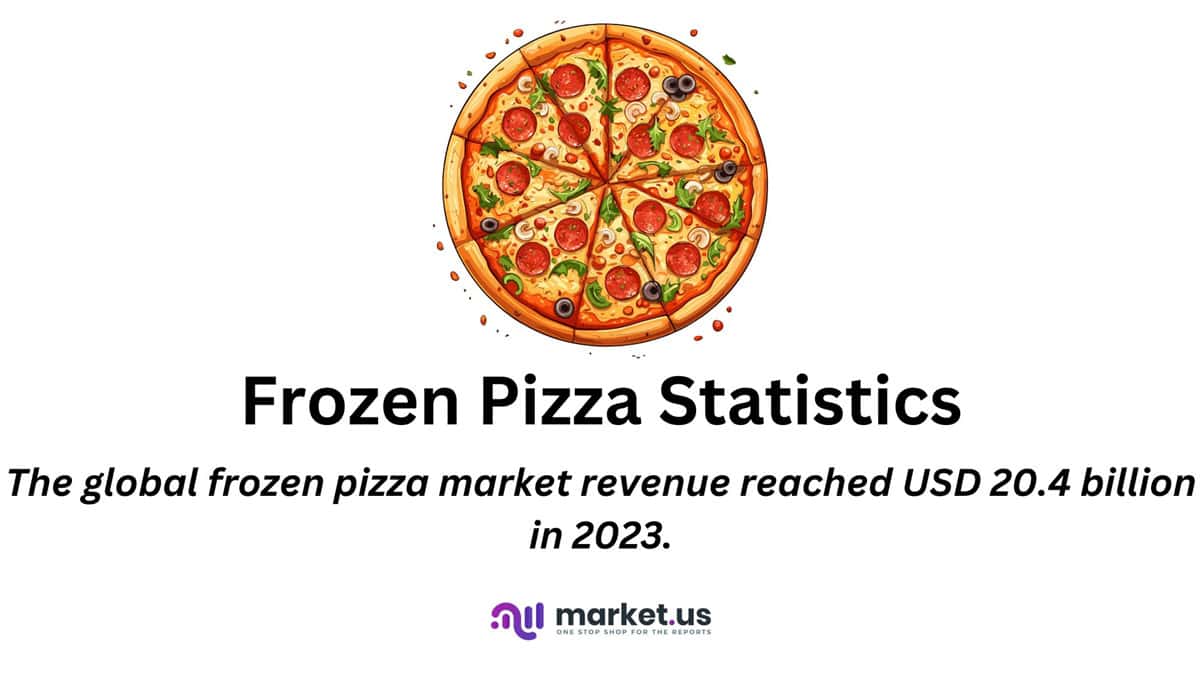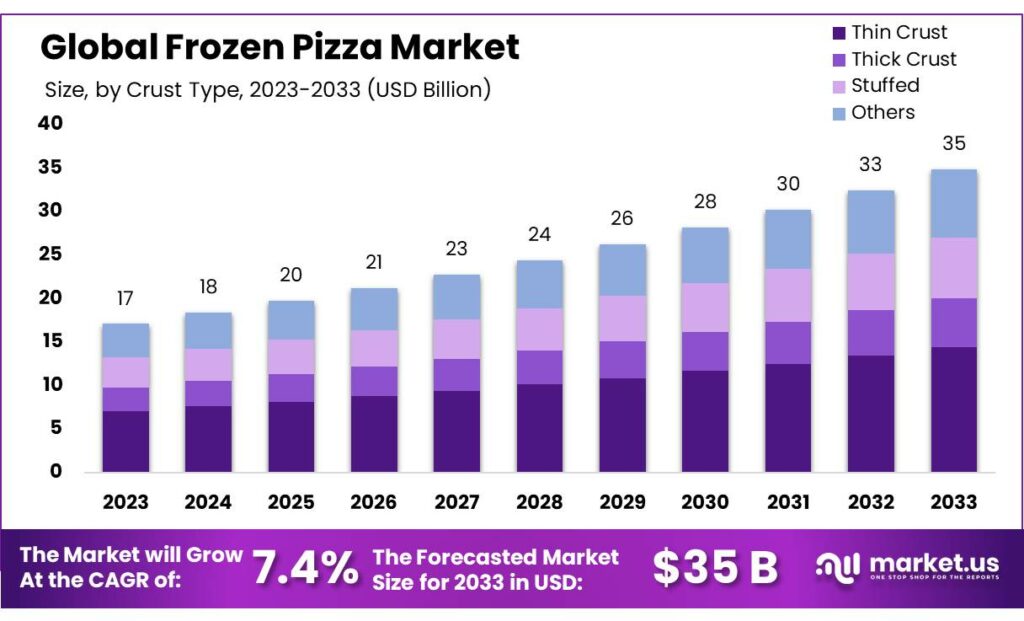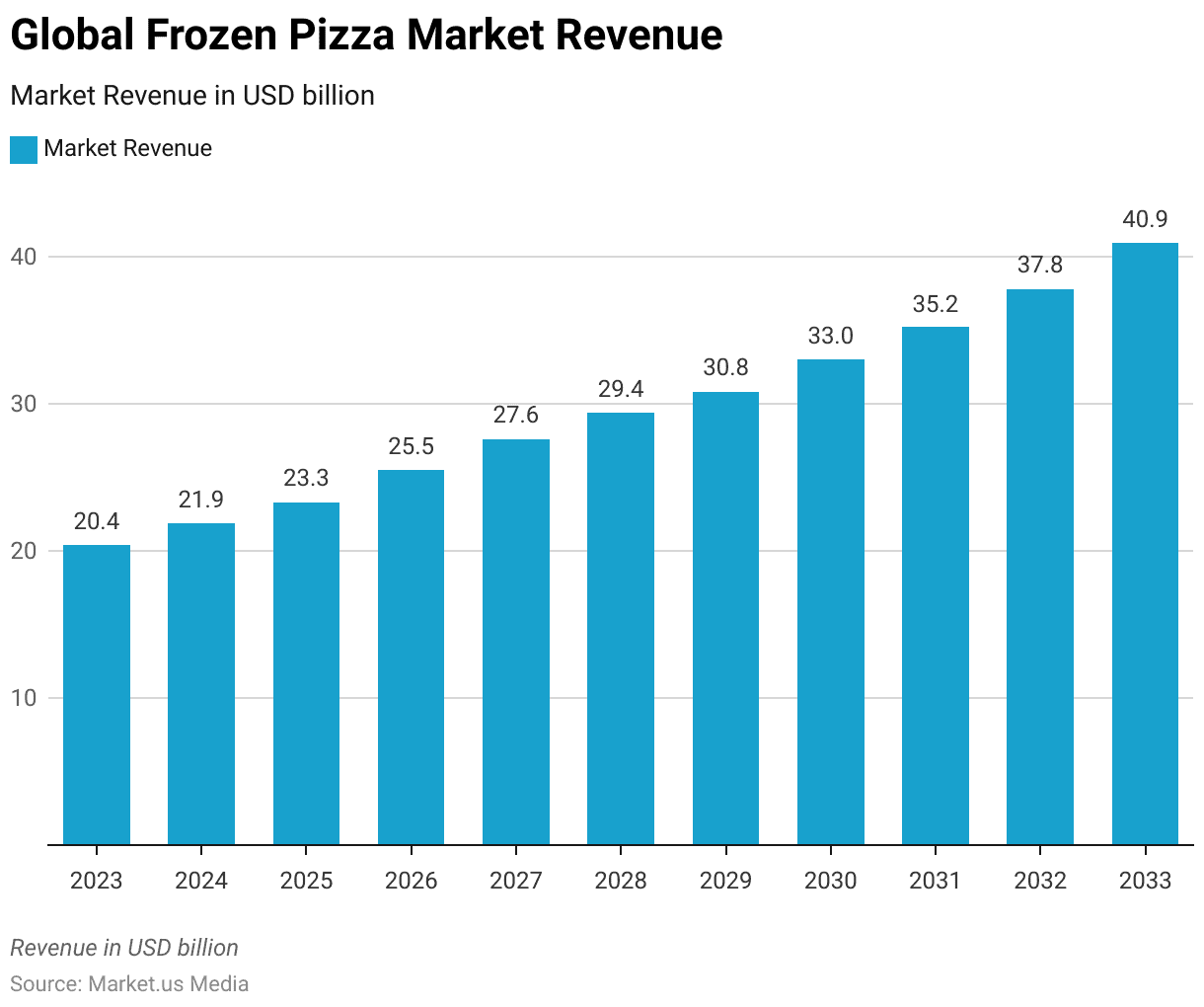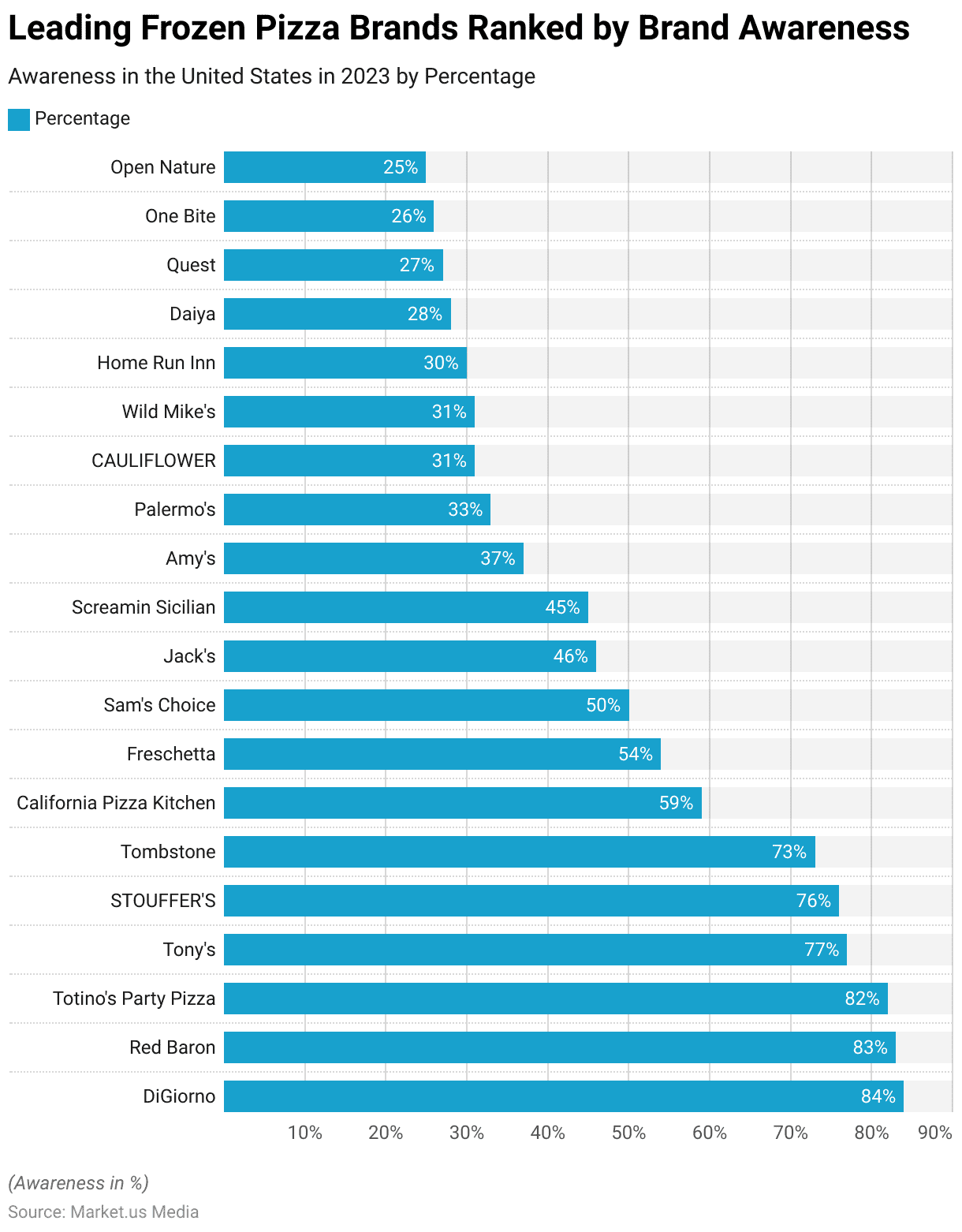Table of Contents
- Introduction
- Editor’s Choice
- Global Frozen Pizza Market Overview
- History and Evolution of Frozen Pizza Statistics
- Leading Frozen Pizza Brands Ranked by Brand Awareness
- Frozen Pizza Sales and Prices Statistics
- Consumption of Frozen Pizza Statistics
- Preferred Frozen Pizza Flavors Statistics
- Key Consumer Trends and Response
- Changing Preferences Among Consumers Due to Inflation
- Recent Developments
- Conclusion
- FAQs
Introduction
Frozen Pizza Statistics: Frozen pizza, a household staple worldwide, offers convenience and variety. Typically composed of a crust and assorted toppings and packaged in cardboard boxes. Production involves dough preparation, application, flash-freezing, and packaging.
With a global presence in supermarkets and online food delivery platforms, frozen pizza comes in diverse varieties, including gluten-free and vegetarian options.
Branding and marketing drive consumer choices in a competitive market where established brands and newcomers vie for market share through innovation and pricing strategies.
Understanding these basics provides insight into the broader landscape of the frozen pizza industry, including market trends and growth opportunities.

Editor’s Choice
- The global frozen pizza market revenue reached USD 20.4 billion in 2023.
- In 2029, the market revenue is estimated to reach USD 30.8 billion, with non-vegetarian pizzas contributing USD 19.03 billion and vegetarian pizzas USD 11.77 billion.
- As of the latest data, meat toppings dominate the market with a commanding 56% share. Indicating a strong preference for protein-rich options among consumers.
- In 2023, DiGiorno secured the highest brand awareness percentage at 84% in the U.S.
- According to data from Circana for the 52 weeks ending April 23, 2023. The frozen pizza subcategory in the United States saw a significant increase of 10.7% in dollar sales. Reaching $6.8 billion across various retail channels such as grocery, drug, and mass market.
- Among respondents, 36% enormously liked spicy food, 53% favored chicken, and 32% preferred pepperoni to an extreme degree.
- About 60% of consumers mentioned consuming frozen or delivered pizza once a week or every two to three months.

Global Frozen Pizza Market Overview
Global Frozen Pizza Market Size Statistics
- The global frozen pizza market revenue has shown a steady upward trajectory over the years at a CAGR of 7.4%. Reaching USD 20.4 billion in 2023 and experiencing consistent growth after that.
- By 2024, the revenue increased to USD 21.9 billion, marking a notable progression.
- This trend continued, with revenues climbing to USD 23.3 billion in 2025 and USD 25.5 billion in 2026.
- The market witnessed substantial expansion, surpassing USD 27.6 billion in 2027 and USD 29.4 billion in 2028.
- In 2029, the revenue peaked at USD 30.8 billion, showcasing sustained market demand.
- The upward momentum persisted, with revenues hitting USD 33.0 billion in 2030 and rising to USD 35.2 billion in 2031.
- By 2032, the market revenue surged to USD 37.8 billion, highlighting significant growth opportunities.
- This positive trajectory is expected to continue, with revenue projections reaching USD 40.9 billion in 2033. Reflecting frozen pizza products’ enduring popularity and consumer appeal globally.
(Source: marketresearch.biz)

Frozen Pizza Market Size – By Type Statistics
- The global frozen pizza market, segmented by type into non-vegetarian and vegetarian options, has consistently grown.
- In 2023, the total market revenue stood at USD 20.4 billion, with non-vegetarian pizzas generating USD 12.61 billion and vegetarian pizzas contributing USD 7.79 billion.
- This trend continued with the market expanding to USD 21.9 billion in 2024, with non-vegetarian revenue at USD 13.53 billion and vegetarian revenue at USD 8.37 billion.
- By 2025, the market will reach USD 23.3 billion, with non-vegetarian pizzas accounting for USD 14.40 billion and vegetarian pizzas for USD 8.90 billion.
- The growth trend persisted, with the market revenue climbing to USD 25.5 billion in 2026, USD 27.6 billion in 2027, and USD 29.4 billion in 2028.
- In 2029, the market revenue reached USD 30.8 billion, with non-vegetarian pizzas contributing USD 19.03 billion and vegetarian pizzas USD 11.77 billion.
- This upward trajectory continued through 2030 and 2031. With the market reaching USD 33.0 billion and USD 35.2 billion, respectively, before peaking at USD 40.9 billion in 2033.
- Throughout this period, both non-vegetarian and vegetarian segments experienced significant growth. Reflecting the diverse preferences of consumers worldwide in the frozen pizza market.
(Source: marketresearch.biz)

Frozen Pizza Market Share – By Toppings Statistics
- The global frozen pizza market’s distribution of market share by toppings reveals distinct preferences among consumers.
- As of the latest data, meat toppings dominate the market with a commanding 56% share. Indicating a strong preference for protein-rich options among consumers.
- Following behind are vegetable toppings, holding a significant 26% share, reflecting the growing demand for healthier and plant-based choices.
- Cheese toppings, renowned for their classic appeal, secure a respectable 14% market share.
- Meanwhile, other toppings collectively make up 3% of the market share. Indicating a smaller but still notable niche within the industry.
- This breakdown underscores the diverse array of preferences among consumers. It highlights the importance of offering various topping options to cater to different tastes and dietary preferences in the global frozen pizza market.
(Source: marketresearch.biz)
Take advantage of our unbeatable offer - buy now!


History and Evolution of Frozen Pizza Statistics
- The method of flash-freezing, pioneered by Clarence Birdseye in 1924, revolutionized food preservation, including pizza.
- However, the origins of the development of frozen pizza for mass consumption are contested. Joe Bucci is one claimant, having patented a method for freezing dough in 1950 to prevent sogginess, ideal for frozen pizza.
- Another contender is Emil De Salvi of Chicago, who in 1951 was credited with perfecting frozen pizza with various fillings, catering to the burgeoning television viewing audience.
- In 1962, due to overwhelming demand at their physical store. The Totinos seized the opportunity and enthusiastically ventured into the frozen pizza market. By the late 1960s, they had emerged as the leading brand in the frozen pizza sector in the United States.
- In 1979, Schwan initiated a marketing campaign with the formation of the “Red Baron Squadron,” using World War II-era biplanes.
- Over nearly three decades, these planes, renowned for their aerobatics and likely affinity for pizza, flew over 80,000 passengers. Becoming the longest-serving civilian aerobatic team in the United States. Presently, Red Baron remains Schwan’s leading frozen pizza brand.
- In 1995, according to Brendan Koerner in The New York Times in 2004, the introduction of Kraft Foods’ DiGiorno brand marked a pivotal moment in the history of frozen pizza.
- Before this, frozen pizzas were often criticized for their tough crusts, bland sauce, rubbery cheese, and tough meat. However, the arrival of DiGiorno’s first pizza revitalized the industry, offering consumers a higher-quality frozen pizza experience.
(Source: Rouses Markets)
Leading Frozen Pizza Brands Ranked by Brand Awareness
- In 2023, brand awareness rankings for leading frozen pizza brands in the United States highlighted the dominance of household names in the market.
- Topping the list, DiGiorno secured the highest brand awareness percentage at 84%, closely followed by Red Baron at 83% and Totino’s Party Pizza at 82%. These established brands have successfully penetrated the consumer consciousness with their marketing efforts and product quality.
- Tony’s and Stouffer’s also garnered substantial recognition, with 77% and 76% brand awareness percentages, respectively.
- Further down the ranking, Tombstone, California Pizza Kitchen, and Freschetta maintained respectable positions, with awareness levels ranging from 73% to 54%.
- While some niche brands, such as Amy’s and Palermo’s, demonstrated moderate awareness at 37% and 33%, respectively, others like CAULIFLOWER and Wild Mike’s trailed slightly behind.
- Despite the fierce competition, these rankings underscore the significance of brand visibility and consumer perception in driving the success of frozen pizza brands in the competitive U.S. market.
(Source: Statista)

Frozen Pizza Sales and Prices Statistics
- Last year, frozen pizza sales surged by 11%, attributed to heightened promotional efforts by retailers. Consequently, 13% of pizza restaurant customers opted for frozen or non-restaurant pizza due to inflation, per a recent report from marketing firm Vericast.
- Additionally, the top four pizza companies experienced a 3% decline in market share.
- According to data from Circana for the 52 weeks ending April 23, 2023, the frozen pizza subcategory in the United States saw a significant increase of 10.7% in dollar sales, reaching $6.8 billion across various retail channels such as grocery, drug, and mass market.
- However, unit sales experienced a decline of 2.8%, totaling less than 1.4 billion units sold. The average price per unit rose notably by 13.9% to $4.94.
- On the other hand, the smaller subcategories of frozen pizza crusts/dough and pizza kits/toppings faced challenges, with respective decreases in dollar sales of 1.5% to $44.1 million and 11.2% to $6.2 million.
- The dollar sales for whole pizzas surged by 16.3% to $1.2 billion, with unit sales increasing by 8.7% to 160.7 million. This growth occurred alongside a 7.0% price rise, reaching $7.50 per pizza.
- Similarly, sales of pizza slices experienced an 18.3% increase, totaling $630.2 million, with volume up by 8.5% to 240.5 million slices. Pizza slice prices also rose 9.0%, reaching $2.62 per slice.
- Additionally, sales of pizza sauce increased by 13.9% to $179.6 million. Shelf-stable kits/mixes saw a modest increase of 0.6% to nearly $30 million, while crust mixes saw a notable uptick of 18.3% to $17.7 million.
(Source: Restaurant Business Magazine, Circana)
Consumption of Frozen Pizza Statistics
- The consumption of frozen pizzas in the United States, purchased in a frozen state has exhibited a steady trend from 2014 to 2024.
- According to the provided data, the consumption figures indicate consumers’ consistent preference for this convenient food option.
- From 2014 to 2015, there was a marginal increase in consumption, with figures rising from 198.14 million to 198.65 million.
- Despite minor fluctuations in subsequent years, the overall trajectory reflects a stable demand for frozen pizzas.
- Notably, 2020 witnessed a notable uptick, with consumption reaching 203.13 million, possibly influenced by lifestyle changes and the convenience of frozen food options during the COVID-19 pandemic.
- In subsequent years, including 2021 to 2024, they maintained a similar pattern. With consumption figures hovering around the 200 million mark.
- This consistency suggests a sustained appeal for frozen pizzas among U.S. consumers. Reaffirming its position as a popular choice in the ready-to-eat food market.
- Moreover, the relatively low percentage of respondents indicating “No” or “Don’t know/no answer” reflects a high level of awareness and engagement with this product category among the population.
(Source: Statista)

Preferred Frozen Pizza Flavors Statistics
- Consumer preferences for frozen pizza based on various flavors were analyzed across three categories: spicy food, chicken, and pepperoni.
- The data, presented as percentages, reveal distinct patterns. Among respondents, 36% enormously liked spicy food, 53% favored chicken, and 32% preferred pepperoni to an extreme degree.
- Moderately, 34% moderately liked spicy food, 28% for chicken, and 37% for pepperoni.
- Moreover, 18% found spicy food just fine, along with 17% for chicken and 27% pepperoni.
- Disinterest was noted, with 10% showing a moderate dislike for spicy food, 1% for chicken, and 3% for pepperoni.
- A minimal percentage, 2% for spicy food and 1% for chicken and pepperoni indicated an extreme dislike.
- These findings elucidate nuanced consumer inclinations toward frozen pizza flavors, highlighting variations in preferences across flavor profiles.
(Source: ThaiScience)

Key Consumer Trends and Response
- About 60% of consumers mentioned consuming frozen or delivered pizza once a week or every two to three months. On the other hand, approximately 70% of consumers reported preparing homemade pizza, albeit less frequently than other options, with 52% indicating they make it once a month or less.
- Interestingly, among those who made homemade pizza, there was a division in whether they used homemade or store-bought dough.
- With inflation concerns at the forefront, consumers are increasingly mindful of prices, prompting grocery stores to enhance their pizza offerings. Over the last two years, retailers have significantly ramped up promotions for frozen pizza brands, experiencing a 214% increase, which hasn’t gone unnoticed by consumers.
- Notably, 43% of individuals who recently dined at pizza restaurants now opt to purchase frozen pizza during a typical week.
- This shift towards at-home pizza consumption is underscored by a nearly 11% surge in frozen pizza sales over the past year alone. Consequently, retailers are capitalizing on this trend, witnessing market share and consumer spending growth.
(Source: Brisan Group, Vericast)
Changing Preferences Among Consumers Due to Inflation
- Most surveyed consumers (64%) believe that the rising prices of dining out make it too costly. However, 41% acknowledge that increasing food prices at grocery stores doesn’t necessarily make eating at home cheaper.
- Consequently, consumers are seeking cost-effective options and are drawn to deals. Half (50%) rely on coupons and discounts when choosing restaurants; these savings can persuade 53% to try new dining establishments.
- Moreover, 42% of those who dine out frequently use Save Direct Mail to decide where to eat, with nearly 80% admitting they spend more at restaurants when offered a coupon or discount.
- Among regular pizza consumers, 58% report that a coupon or discount influenced their dining decisions in the past month.
- Loyalty rewards play a crucial role, with consumers increasingly inclined to switch to restaurants that offer discounts, particularly among Gen Z consumers, where there has been a 9-percentage-point increase since 2021.
(Source: Vericast)
Recent Developments
New Product Launches:
- In November 2022, Dr. Oetker’s brand, The Good Baker, introduced The Meat-Free Chicken Style pizza, featuring a stone-baked crust and marinated chicken-style pieces.
- Schwan’s Consumer Brands, Inc. launched five new pizzas and frozen pies in October 2022, increasing its home delivery product options. Additionally, in September 2022, Schwan’s introduced a new pizza brand called Hearth & Fire, supported by digital advertising on various platforms.
Acquisitions and Joint Ventures:
- In April 2023, Nestlé and PAI announced a joint venture to expand their presence in the European frozen pizza market.
- Continuing its expansion strategy, Nestlé also completed the acquisition of a majority stake in a premium chocolate company in Brazil in September 2023.
Market Trends:
- There is an increasing demand for dietary-specific pizzas such as gluten-free and vegan options, driven by consumer health consciousness and dietary restrictions. This has prompted manufacturers to innovate in gluten-free organic and natural ingredients.
- The bacon topping segment is projected to grow rapidly, favored for its unique flavor profile which pairs well with various pizza styles.
Strategic Partnerships:
- Collaboration between a leading frozen pizza brand and a celebrity chef to co-create signature pizza recipes, leveraging the chef’s culinary expertise and brand appeal to drive product differentiation and consumer engagement.
- The partnership between a frozen food manufacturer and a technology company to develop innovative packaging solutions that enhance product freshness and convenience, addressing consumer demand for hassle-free meal options.
Technological Advancements:
- Integration of state-of-the-art freezing technologies and packaging innovations to extend shelf life and maintain product quality during storage and transportation, ensuring consumer satisfaction and reducing food waste.
- Implementation of data analytics and predictive modeling tools to optimize production planning and inventory management, enabling manufacturers to respond swiftly to changing market dynamics and consumer preferences.
Conclusion
Frozen Pizza Statistics – In summary, the frozen pizza sector continues to thrive and adapt, fueled by convenience, affordability, and changing consumer tastes.
Steady growth in revenue and consumption is evident, supported by strong branding and increased marketing by retailers.
Innovations in flavor variety, packaging, and production technology have broadened appeal and improved sustainability. Despite challenges like inflation, frozen pizza remains a popular choice for its convenience.
Looking ahead, the industry has opportunities for expansion through ongoing innovation, partnerships, and targeted marketing strategies.
Overall, the future looks promising for the frozen pizza market. Where it is poised to meet evolving consumer demands globally.
FAQs
Frozen pizza can typically be kept in the freezer for several months. Check the packaging for specific storage instructions, but generally, it’s best to consume frozen pizza within 3-6 months for optimal taste and quality.
Yes, most frozen pizzas come pre-cooked. They are designed to be heated thoroughly in the oven or microwave before consumption. Follow the instructions on the packaging to ensure the pizza is heated evenly and reaches a safe internal temperature.
While an oven is preferred for cooking a frozen pizza, cooking it with other appliances, such as a toaster oven or grill, is possible. Adjust the cooking time and method according to the appliance used to ensure the pizza is heated evenly and cooked through.
Many brands offer gluten-free frozen pizza options to cater to individuals with gluten sensitivities or dietary restrictions. Look for gluten-free labels on the packaging or check the ingredient list for gluten-free crust options.
Many brands offer vegan frozen pizza options made with plant-based cheese and toppings. Look for labels indicating “vegan” or check the ingredient list for dairy-free and meat-free options.
Discuss your needs with our analyst
Please share your requirements with more details so our analyst can check if they can solve your problem(s)



